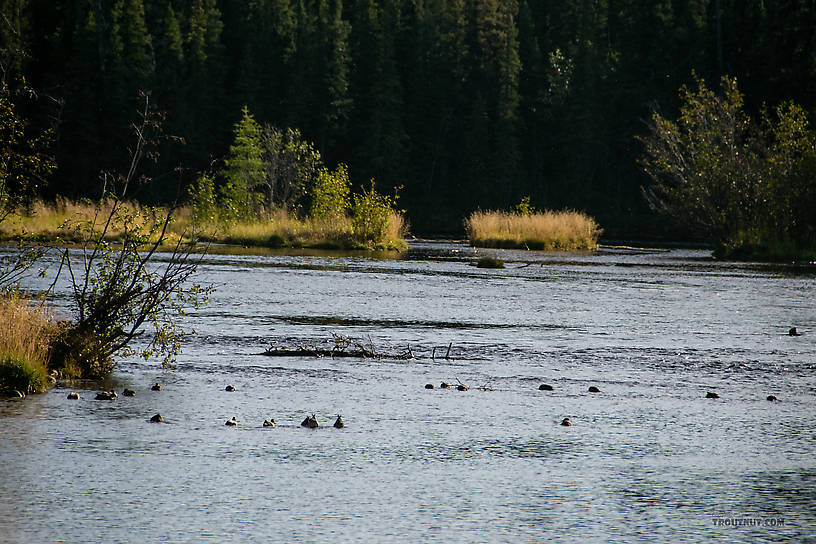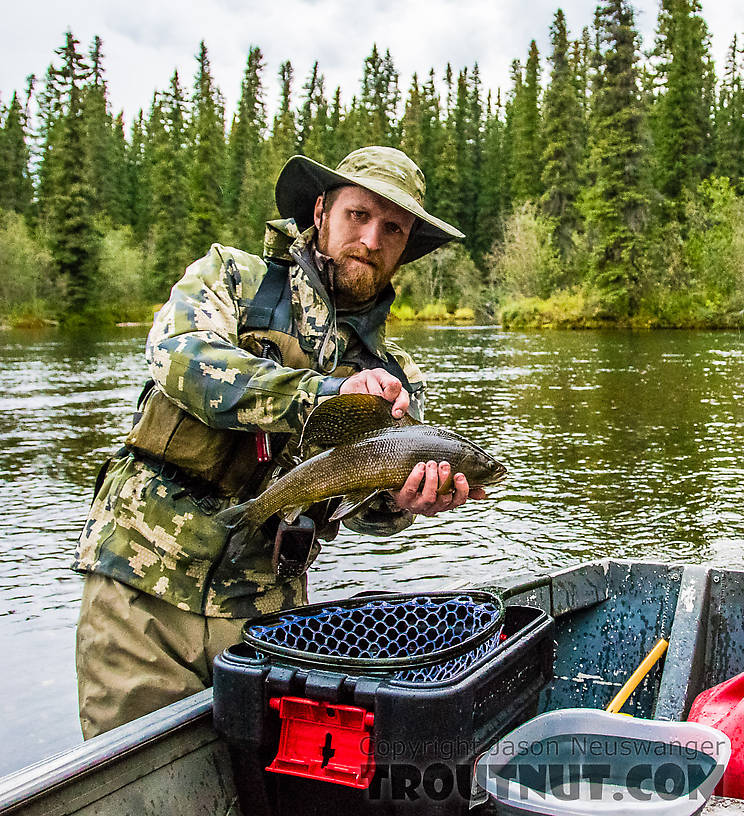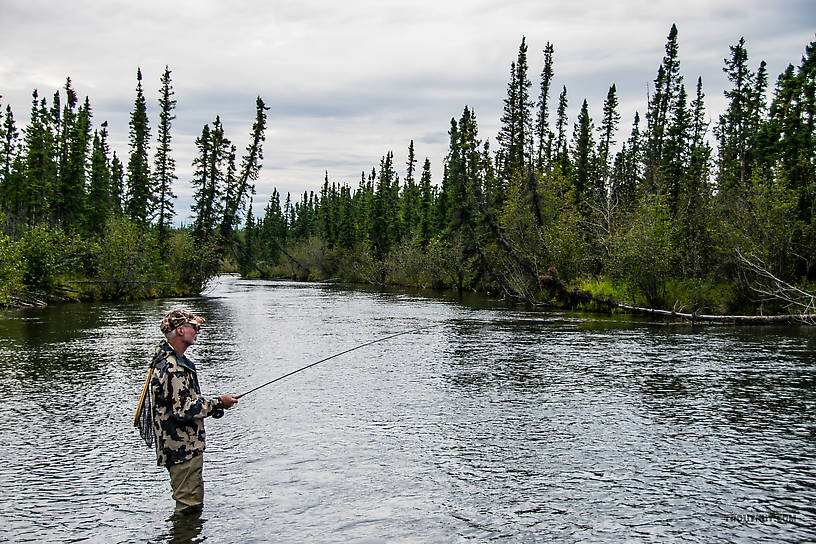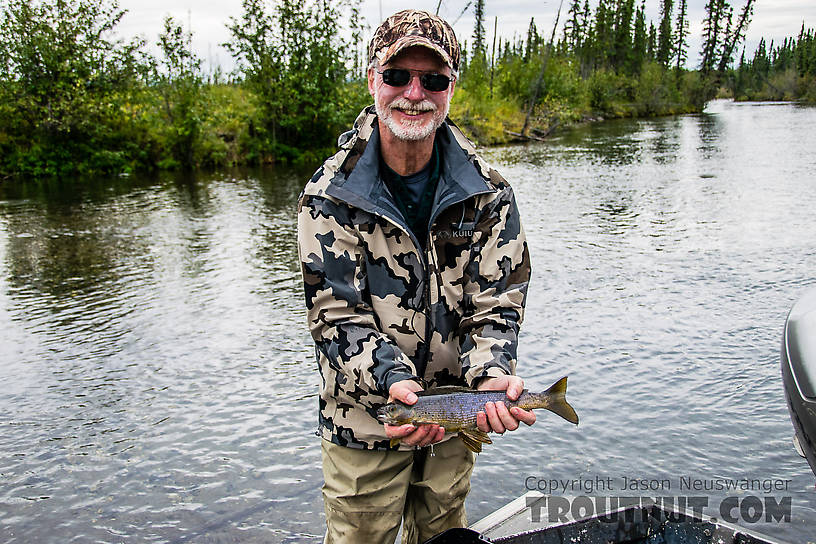Blog & Latest Updates
Fly Fishing Articles
Insects by Common Name


Wilderness Grayling - Day 1
I arose before Jason and staggered out into the cool damp morning to discover that light rain overnight had left only a few smoldering embers in an otherwise soggy fire pit. Everything, including all potential kindling, was damp. The weather looked promising as the sun ascended into the clear blue southeastern sky, so we decided to forego a morning fire and simply heat water for coffee and granola. Jason took many photos this morning, but they did not capture the pristine crispness of the sub-arctic air; nor did they convey the quiet tranquility that reigns over this remote place.

Interrupted only by the rare vocalizations of ravens and ducks, the river gurgled around our peninsular campsite, caring not one whit about the comings and goings of men. Awareness of humanity’s relatively insignificant role in the natural cycle of life is one of the gifts of wilderness travel.
As I was filtering river water to fill our 3-liter bags and 1-liter bottles, a lone hen pintail sailed into the slack water on the far side of our wide bend in the river and spent (Spent: The wing position of many aquatic insects when they fall on the water after mating. The wings of both sides lay flat on the water. The word may be used to describe insects with their wings in that position, as well as the position itself.) the mid-morning hours feeding on some type of invertebrate. There were no plants growing in the shallow gravel where she fed. A pair of hen widgeon puddled around in similar spots near the far shore, also feeding on something non-vegetative. Upstream about 200 yards, a flock of 20-25 puddle ducks (probably widgeon and a few mallards) were also feeding on something besides plants in a relatively shallow, slack-water area near shore. Water temperature in this crystal clear, gravel-bottomed river was only 40F. I wish we knew what kind of non-vegetative food all these puddle ducks were eating.

By mid-morning we were preparing for a day of field-testing equipment and procedures. I assembled the camera calibration frame and made other preparations while Jason checked batteries, camera settings, and underwater housings. By 10:00 a.m. we were in our chest waders and exploring the river near camp, running logistical tests on drift-net deployment, current velocity measurement, positioning of the modified camera array tripod to film drift-feeding grayling, and anaesthetizing fish Jason caught on his fly rod so we could remove their stomach contents by gastric lavage. The drift-net quickly filled with tiny particles of debris, convincing Jason that mesh size needed to be larger. Water-soaked grains of cous cous acquired near-neutral buoyancy and worked better than tapioca balls as tracers to monitor current velocity by underwater video. The modified tripod worked much better than at Mystery Creek #170. And grayling were suitably calmed after spending a minute or so in a dilute solution of sparkling water with high carbon dioxide concentration, allowing us to pump, filter, and preserve stomach contents before releasing the fish unharmed near their point of capture.

By late afternoon we were ready to explore other reaches upstream that might hold promise for filming and capturing drift-feeding grayling. Just before departing from camp, a jet boat rounded our peninsula heading upstream, piloted by a serious-looking, gray-bearded fellow who fit the archetypal appearance of the grizzled sourdoughs who built Alaska. When we traveled upstream ourselves, we found it necessary to disturb him momentarily by motoring past the spot he had stopped to fish near the mouth of a small tributary; but we executed our intrusion as respectfully as possible. Not long after we had arrived at a place Jason had scouted previously, the old-timer (I should talk) motored up from below, anchored, and began fishing just downstream of us. I did not know what to make of this, because there were lots of places to fish that were not immediately adjacent to the only other boat on the river. Soon he called out, “Are you guys packing?” I thought it was an odd first question, and, having been warned about the territoriality of a few of the area’s residents, I was not sure whether it was even wise to respond to such an inquiry. Jason told him we were not carrying firearms at the moment.
At this point our new companion’s good intentions became clear, as he alerted us that two large boar grizzlies had been hunting moose in the area all summer. Just a few days earlier, he had watched one of them fighting a large cow moose in the river just upstream of our current location. Of course, we appreciated the “heads-up” and took proper precautions the next day. The gentleman turned out to be a highly educated, well-spoken professional from Fairbanks, who typically worked short weeks from Monday to Thursday, then spent (Spent: The wing position of many aquatic insects when they fall on the water after mating. The wings of both sides lay flat on the water. The word may be used to describe insects with their wings in that position, as well as the position itself.) long weekends in a cabin on the river. Jason learned a lot from him about the river and its history, and was happy to have a local contact for information on water levels and other conditions that might affect future sampling trips. To reiterate an old adage, “You can’t judge a book by its cover.”
Our friend headed back downstream at ~5:00 p.m., so we waded into a good-looking run nearby and started catching chunky grayling 15-17 inches long. On a 5-weight fly rod in moderate current, they exhibited the strength and endurance of premier sport fish like rainbow trout and smallmouth bass.

For the next hour or two, we enjoyed outstanding Arctic grayling fishing in a wilderness setting, interrupted only by the need to pump the stomach contents of several specimens. One or more species of caddis fly larvae still in their small-pebble cases dominated the diet, indicating that grayling were not only drift-feeding, but also grazing on the gravel substrate.

To reiterate a question that has been posed to me occasionally over my 35-year career in fishery management, “How do I get a job like this?”
We called it a day at about 9:00 p.m. and motored back downstream to camp shortly before dark. The day had been warm and sunny, so we had ample dry kindling to start a fire. We enjoyed a relaxing, if short, evening around the campfire eating our Mountain House meals and planning for tomorrow before crawling into our sleeping bags as the calm chill of a Northern night fell upon us. It had been an interesting and productive day.
Photos by Troutnut from Mystery Creek #186 in Alaska













Most recent comments on this post (latest on top)
Comment on this post
Top 10 Fly Hatches
Top Gift Shop Designs
Eat mayflies.
Top Insect Specimens
Miscellaneous Sites
Troutnut.com is copyright © 2004-2024 Jason
Neuswanger (email Jason). See my FAQ for information about use of my images.
 privacy policy
privacy policy
